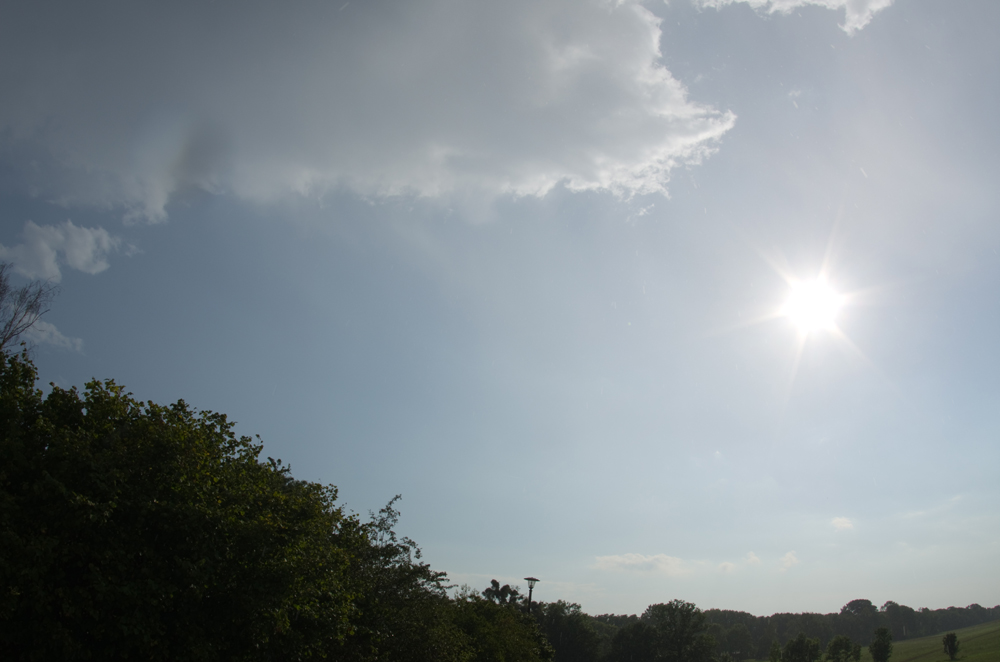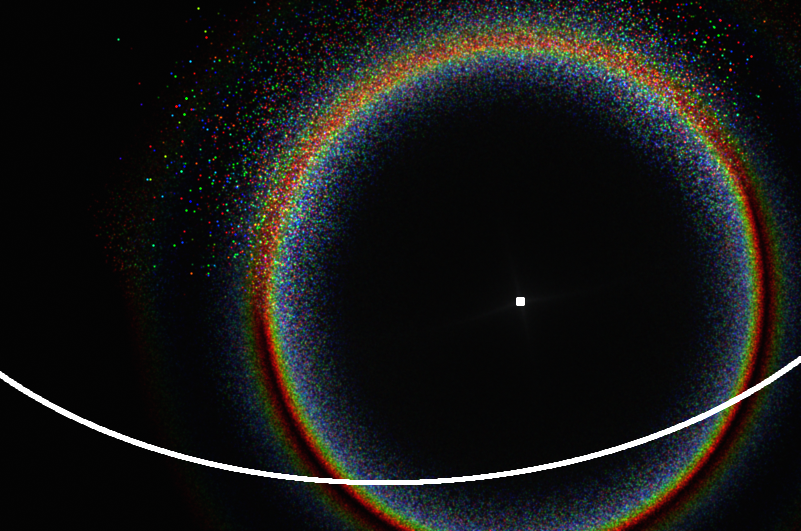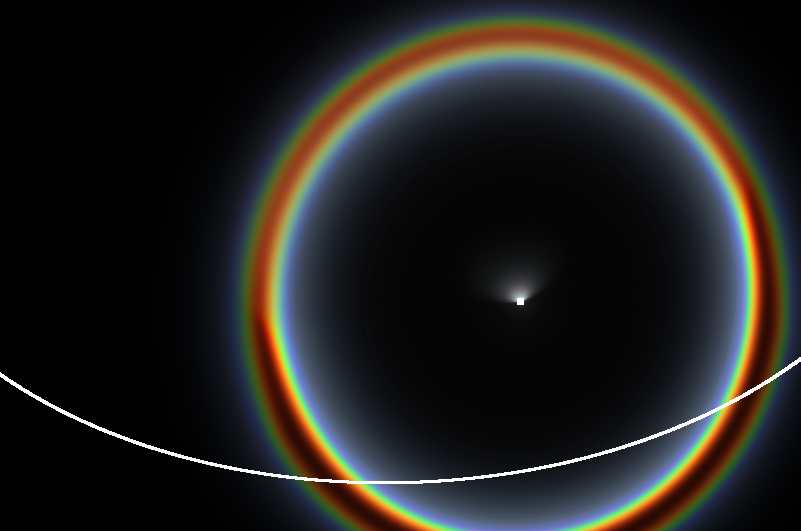Concentric 3rd and 4th order rainbows at Dresden-Langebrück, Aug 11th, 2020




Taking photographs of tertiary and quaternary rainbows is difficult, as usually you won’t see what you are aiming at – theory predicts that the tertiary is just at the threshold of visibility [1], and for the quaternary the situation is even worse. I myself have been lucky only once before [2], (though having tried for almost a decade now), if one does not count experiments using artificial sprays [3]. This cannot be attributed to a lack of opportunities. Over the years, I experienced several promising situations, but afterwards no higher order rainbows could be extracted from the photographs by image processing. One problem is that cloud structures in the background mess up the unsharp mask filter. But maybe also my timing was just wrong and these rainbows did not appear when I expect them to do, because I misjudged the shower and illumination geometry.
Anyway, on Aug 11th, 2020, my instincts were right. Just before I finished work in Dresden-Langebrück, a moderate shower moved in from the northeast. The sunlight was somewhat dim, which resulted in an unspectacular primary rainbow from 17:15 CEST onwards. I could see some larger drops glint in the sunlight. I went to my car on the parking lot during the next minutes, and lost sight to the east, so I do not exactly know what happened later on this side of the sky. The rain was still ongoing, but not heavy, there were people cycling around without looking too much disturbed. I’m not entirely sure if it was still the same rain shower, or another one which had meanwhile moved in. I took three photos at the parking lot (17:23-24 CEST), and then drove about 100 m to a spot with a good view towards the west. There was nothing to be seen with the naked eye, just the sun, some glinting raindrops, a cloud, and blue sky below. A major problem is that raindrops will fall on the front lens, especially when using a fisheye objective that cannot be shielded and has to be held out of the car window to make proper use of its field of view. So one needs to be fast, otherwise the images will be spoiled by artifacts from the drops. That is why I did not do any image stacks, just a threefold exposure bracket per shot for safety (to have at least one picture with a useful exposure). In between, I had to wipe the lens dry. All of the ten shots I took there from 17:26-30 showed the tertiary rainbow after some processing, and it also appeared on the earlier pictures from the parking lot, as far as the view permitted. I was rather overwhelmed to see more than the complete upper half of the tertiary against the blue sky and cloud background when I first applied an unsharp mask to the images. The quaternary rainbow (located just outside the tertiary) can also be detected beyond any doubts, especially on the left side. I found no supernumerary arcs and no traces of the seventh order [4] (which I had missed to pay attention to during the observation, I also did not use any polarizers, and as mentioned, I did not record image stacks).




It is well known that aerodynamic flattening of larger raindrops has an impact on rainbows through the so-called Möbius shifts, but so far the consequences for higher order rainbows have only been studied theoretically. Are there any new insights from this observation? This, of course, requires an image calibration, i.e. the assignment of scattering coordinates (scattering angle and clock angle, i.e. the sun-centered azimuth, which I will count clockwise from the rainbow’s top here) to the individual pixels. The position of the sun is easily calculated from the time the respective photograph was taken (17:27:54 CEST for the top image, checked with a radio-controlled watch) and the location (51.13° N, 13.83° E), which gives in this case an elevation of 27.6° and an azimuth of 259.5°. The pixel coordinates of the sun’s center could also be reliably determined from an image version developed as dark as possible from the RAW file in Photoshop. The projection of this specific lens I had measured eight years ago (when I newly got it), but I did also a cross-check with recent starfield pictures (abundantly available from my attempts to catch Perseid meteors the following nights). In order to determine the relevant Euler angles (elevation and azimuth of the camera’s optical axis, and the rotation of the camera sensor chip around this axis), I still needed another reference mark. Luckily there was a telecommunication tower at the horizon which I could identify and then calculate under which elevation and azimuth it is seen from the observing location.
Technical sidenote: The two coordinates of the reference mark provide me indeed with one condition more than the number of available degrees of freedom, so I can check the overall consistency of the calibration. And here it initially turned out to be not very convincing. What went wrong? When checking my hidden assumptions I found that I had pinned the piercing point of the optical axis to the precise center of the CMOS sensor (in terms of pixel coordinates). This may not be realistic, and, moreover, in a Pentax K-5 camera the sensor can move several millimeters to compensate for shaking. Even with the shaking compensation turned off there is no guarantee that it will find and stay in the optical center position (plus, there are decentering errors of the lens). From the working principle of the calibration procedure I expect the decentering error to be of quadratic order, and it may turn out to be negligible for longer focal lengths. But it matters for a fisheye lens. So I used the amounts of decentering in X and Y as further degrees of freedom and achieved consistent results for a shift of 26 pixels (0.12 mm) in the horizontal (and zero in the vertical). However, a further reference mark would be needed for a truly unique determination. Then there would still remain the assumption of a rotationally symmetric lens, but this seems to be acceptable as indicated by the recent starfield test.
From an equilateral projection in scattering coordinates it can then be deduced that the tertiary does not bend significantly over the recorded range of clock angles, which also holds for the quaternary as far as it peaks out of the noise. So seemingly they appeared as perfectly concentric circles here!

This is somewhat surprising, as theory predicts that these rainbows are also subject to Möbius shifts of various amounts along their circumference, which should become noticeable if larger (more distorted) drops are involved. Interestingly, for this sun elevation the Möbius shifts will move the tops of the 3rd and 4th order rainbows towards each other. They might even overlap for an effective drop radius of 0.5 mm [5]. However, in nature, in most cases the drop size distribution (DSD) will cover a broad range of sizes, also including small drops. Because the shape distortion sets in (at least) quadratically with rising drop radius, it is likely to see some of the traditional concentric sphere-drop rainbows shine through in the full mixture of size dependent rainbows. This I already noted in simulations using broad Marshall-Palmer DSDs (i.e. a simple decaying exponential). As mentioned, there was no heavy rainfall going on during the observation on Aug 11th, so a dominance of the less distorted smaller sizes can be reasonably assumed – regrettably there are no direct measurements of the DSD. Lee and Laven [1] argue that broad DSDs tend to wipe out the tertiary’s top and leave only the sides, but their analysis was based on much lower sun elevations than occurring here.
So in order to see how much the concentricity of the tertiary and quaternary rainbows will be affected in this specific case I did some simulations for the proper sun elevation and a (guessed) DSD which contains mostly small and moderate sized drops: A Marshall-Palmer with decaying parameter (Lambda) of 4 mm-1, as previously used [5]. There are two complementary simulation methods which I can apply: 1) GO: Geometric optic raytracing (including polarization, but neglecting interference and diffraction) for all rainbow orders up to the 7th, based on a Beard-Chuang cosine series drop shape model, with optional (2,0) quadrupole mode oscillations and Gaussian tilts of the symmetry axis from the vertical, and 2) DMK: Debye series calculations for spherical drops of various sizes, superimposed in intensity after being shifted in scattering angle by the appropriate Möbius value (depending on drop size, rainbow order, and clock angle, following Können [6]). These calculation include only rainbow orders up to the 5th. The Möbius shifts themselves are taken from a look-up table comprising earlier raytracing results. These were calculated from a simpler shape model (two conjoined half spheroids fitted to Beard-Chuang shapes) and do not include drop oscillations or tilts for the higher-order rainbows yet. However, this second method has the advantage of showing if supernumerary arcs can be expected under the given conditions.
I removed the most disturbing directly transmitted light (sometimes referred to as “zero order glow”) as well as the less important contributions from external reflection and the lowest two rainbow orders from the simulation, and show the resulting clear higher-order rainbows in the same sunward projection (and for the same sun elevation) as in the top image. As a reference, I also let simulations run for spherical drops with the same DSD. These, of course, turn out perfectly concentric (in scattering coordinates, not necessarily in the projected image). After having switched on drop distortions, it is reassuring to see that both methods agree in keeping the upper halves of the tertiary and quaternary well separated and still nearly concentric. However, a tendency to blur these parts can be noted, due to the contribution of larger drops. Two more pieces of information can be extracted here: Introducing moderate axis tilts and (2,0) oscillations (both their amplitude distributions set to the “standard values” used in [7]) does not lead to visible changes in the result (GO), and supernumeraries do not appear, neither for flattened nor spherical drops (DMK).





The latter result illustrates that in broad DSDs supernumeraries need the stabilizing “Fraser mechanism” [8] to become visible: If, with increasing drop size, the Möbius shifts grow in the opposite direction than the supernumeraries’ convergence towards the Descartes angle due to their shrinking angular width, there will be a certain critical drop size at which these effects compensate. Because of the resulting position stability against changes of drop radii, the supernumeraries of drops around the critical size will peak out from the unstructured background of superimposed non-aligned supernumeraries of other sizes. Traditionally, this argument is invoked for the primary rainbow (with a critical drop radius of about 0.25 mm for the first supernumerary), but it holds likewise for all other orders [9]. If the Möbius shifts have the wrong sign (as for the tertiary and quaternary bows at the sun elevation of my observation) or are set to zero (as in the sphere reference simulations), there exists no compensation point and the averaging of all supernumeraries results in a more or less uniform intensity gradient.
The GO simulations reproduce also the 7th order rainbow, but, under the assumed conditions, do not predict any amplification effects for it caused by drop distortions or oscillations. In fact, it is not even recognizable in the simulation pictures shown here, but can be extracted by a larger intensity-to-RGB-value scaling factor (or higher gamma value).
In conclusion, the observed concentric tertiary and quaternary rainbows without supernumeraries can be consistently interpreted in the current theoretical framework of broad raindrop size distributions and drop shapes with aerodynamically plausible amounts of flattening and oscillations. Even though shape distortions have a larger influence on higher orders, they do not forbid that traditionally shaped rainbows are formed, if enough small drops are present. Of course, any observations of genuine non-spherical drop effects such as higher order twinned bows are highly welcome as they would allow for a more challenging test of the simulation models.
Posted on September 27, 2020, in observations, rainbow and fogbow, theory and tagged drop size distribution, higher-order rainbows, Möbius shifts, quaternary rainbow, simulations, tertiary rainbow. Bookmark the permalink. 1 Comment.
Good day! I just would like to give a huge thumbs up for the good information you could have right here on this post. I shall be coming back to your blog for extra soon.